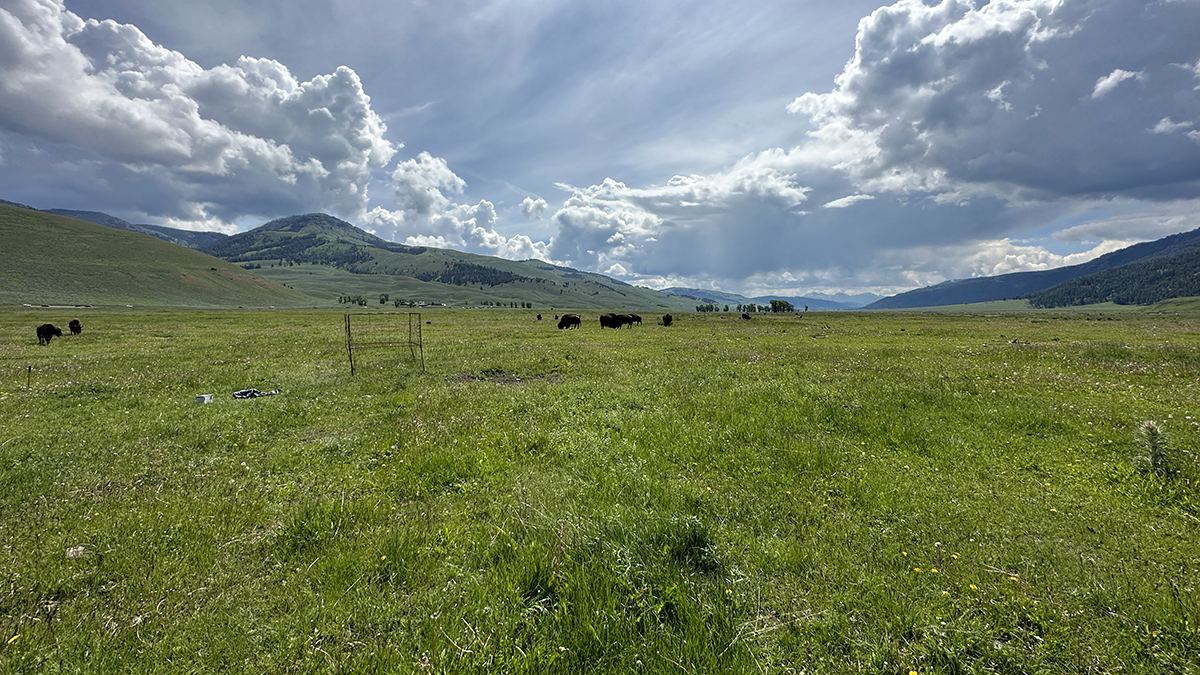By the end of the 19th century, most of the estimated 30 million to 60 million bison roaming North America’s Great Plains had been eradicated, forever changing the landscapes that they lumbered across. Today, only about 400,000 bison remain in North America, and 95% of those animals are raised and managed for meat production. The remaining bison live in carefully controlled conservation settings, such as Yellowstone National Park.
Though existing research suggests that grazing bison can diversify habitats and drive nutrient cycling and productivity, studying how they shape larger, ecosystem-scale landscapes has been difficult. A new study conducted in Yellowstone does just that, showing how bison grazing boosts nitrogen cycling and improves plant health to create resilient grasslands.
Yellowstone offers a unique national laboratory for the study because the 5,000 bison who call the park home range freely along a 50-mile (80-kilometer) migration route. Their migration is a reminder of a time when millions of these massive herbivores roamed the continent.
Grazing Helps the Grass Grow
Researchers measured the plant productivity of 16 Yellowstone sites between 2015 and 2022. These sites spanned across lawn-like valley bottoms, which were grazed throughout grass-growing seasons; dry hillsides, which were grazed in spring, fall, and winter (depending on snowpack); and high-elevation wet areas, which were grazed from early summer until frosts arrived.
“Bison are true grazers. They put their heads down and just do their thing.”
Though other species subsist on these grasses, cameras and GPS data from tracking collars showed bison were the primary grazing animals in these locations. “Bison are true grazers. They put their heads down and just do their thing, whereas elk and mule deer and pronghorn are a little more selective in what they eat,” said study author Bill Hamilton, an ecologist at Washington and Lee University.
To compare areas of vegetation that were and were not grazed by bison, researchers constructed a series of movable “exclosures” that kept bison out of 9-square-meter areas. Some of the exclosures remained fixed in place from April, when snowpack melts and new plants emerge, to October, the time when grasses stop growing. Moveable exclosures, shifted every 30 days, followed the bison along their migration path.
By comparing fenced and unfenced areas, researchers were able to estimate how much biomass had been eaten. The missing biomass was added back into the productivity total to give a fuller picture of plant production. “It would be like if each time you mow your lawn and put it into a bag and then you weighed that pile at the end of the summer, you would know how much your grass you actually grew,” said Hamilton.
Having thousands of large animals grazing at once may seem like it would inhibit plant growth, but the study showed the opposite effects. As bison graze, they speed up the nitrogen cycle in the plants and soil around them. Urine is one concentrated source of nitrogen, and as it enters the soil, enzymes and microbes break it down into ammonia, which is then converted to ammonium. Some plants absorb the ammonium directly, and microbes further convert some of the ammonium into nitrate that is absorbed by other plants.
Populations of ammonium-oxidizing bacteria were concentrated more highly in heavily grazed areas, leading to more available nitrogen for plant growth. Researchers determined nitrogen levels by burying reverse osmosis membranes in the ground and measuring the amount of ammonium and nitrate collected on the membrane after 30 days.
The large amounts of bison urine and feces entering the soil weren’t the only cause of increased nitrogen, Hamilton explained. “We found differences in the amount of nitrogen in the leaf tissue above ground. But where’s it coming from? It’s coming from the nitrogen cycle that’s being stimulated by the grazing.”
Mutually Beneficial
When a bison chomps off the top of a patch of grass, the plants quickly release carbon into the soil through their roots to regrow their lost tissue. The carbon stimulates the microbes belowground to accelerate decomposition and nutrient cycling. “In 7 days, there’s more nitrogen in the leaf tissue of that [grazed] plant than a comparable ungrazed plant,” said Hamilton. “The key is that plants are not passive in this process.”
“Animals, through their natural behavior of congregating and eating and hanging out, are changing the way plant communities grow and respond.”
Increased nitrogen in the grasses means more nutritious food for Yellowstone’s migrating bison herds and resident ruminants: The rise in nitrogen translated to a 156% crude protein increase in lawn-like grasslands, a 155% increase in high-elevation habitats, and a 119% increase in dry areas.
“What this study tells me is that what’s happening in Yellowstone is very special,” said Tyler Kartzinel, an ecologist at Brown University who was not part of the study. “Animals, through their natural behavior of congregating and eating and hanging out, are changing the way plant communities grow and respond. And that has cascading effects on nutrient cycling and the functioning of the entire ecosystem.”
Yellowstone and Beyond
Yellowstone’s free-roaming bison herds provide a glimpse at the past, but they also might offer insight into how to preserve and improve grasslands in the future, the study authors suggest. When large groups of herbivores move freely across landscapes—like wildebeest in the Serengeti and caribou in Alaska—they can influence the broader ecosystem in a positive way.
Restoring bison in large-scale settings allows them to fulfill not only significant ecological roles but cultural roles as well. “That’s important for Indigenous tribes that have spiritual and cultural connections to these animals,” said Hamilton.
Besides Yellowstone, few places exist in North America to study how large grazing animals affect the land that sustains them. The nonprofit American Prairie aims eventually to connect 3.2 million acres (about 1.3 million hectares) of grasslands and host thousands of free-roaming bison in Montana—offering another venue where bison could migrate and interact with plants and soil on a large scale. “This study says it could work,” said Hamilton.
—Rebecca Owen (@beccapox.bsky.social), Science Writer

